Alkmaar is famous for the world’s biggest cheese market, featuring a dazzling performance of workers in white outfits running around carrying 200 pounds of cheese on swinging trays. It can be easily visited as a day-trip from Amsterdam or Haarlem, just 45 minutes away by direct train.
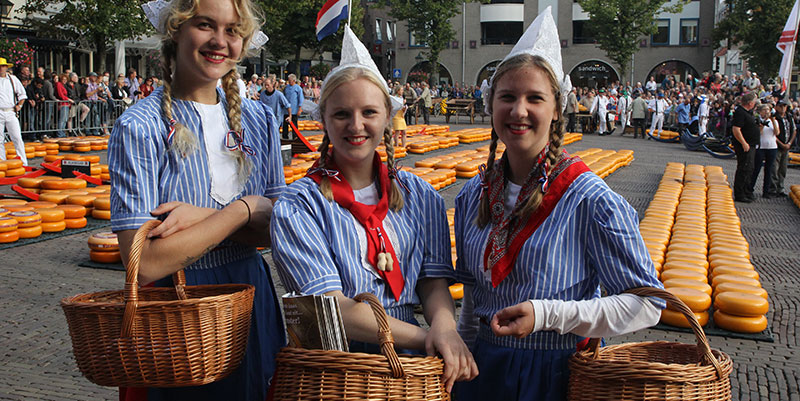
We have a detailed page all about Alkmaar town and the canal boat tour.
Alkmaar is especially lively on cheese market day with lots of sidewalk stands set up selling crafts, foods, clothing, all kinds of souvenirs, some big wooden shoes, and of course, different types of locally produced cheeses. The cheese market is a major visitor attraction in the country and the main reason to visit the city.
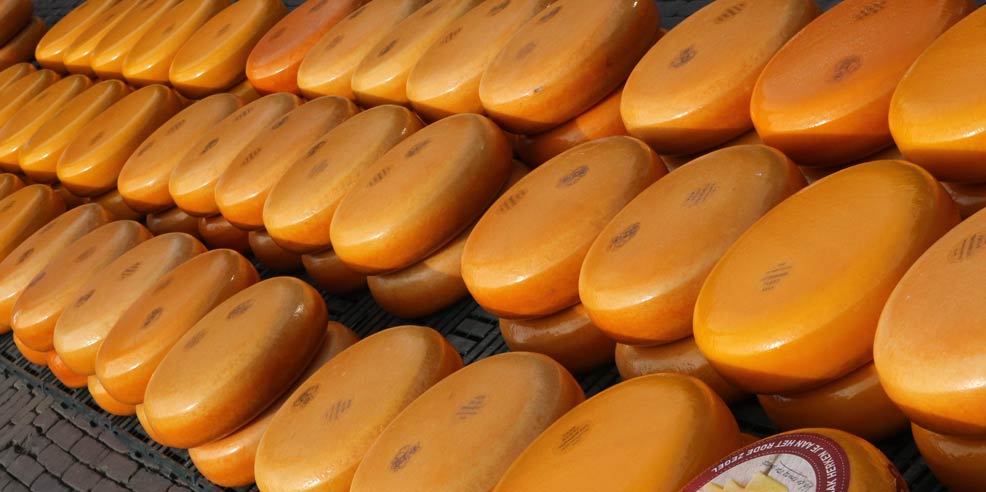
The vast plaza is filled with thousands of large round gouda cheeses waiting to be carried into the weighing house, then hauled back out in a running cycle that goes on all morning. The market has a long history recalling past centuries when cheese was perhaps the most important product of the region. This cheese spectacle happens every Friday from 10 a.m. until just past noon and Tuesday evenings every week from March until the end of September.
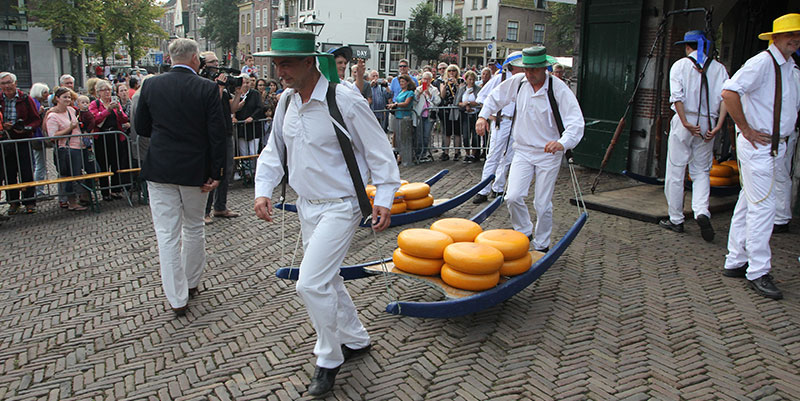
There is no prettier or more characteristic Dutch sight than this cheese market, with guys in white running around carrying big loads of cheese back and forth. Participants in the event are members of the cheese guild, divided up into teams.
View 15-minute video of cheese market:
Almost 700 years ago Alkmaar was already a cheese town. In 1365 the city was granted weighing rights and got their first cheese scale—in 1612 the number of scales increased to four. Markets were the dynamic economic engine in those days. Over time, the growing cheese market frequently needed more room, so houses were sometimes demolished to increase the space.
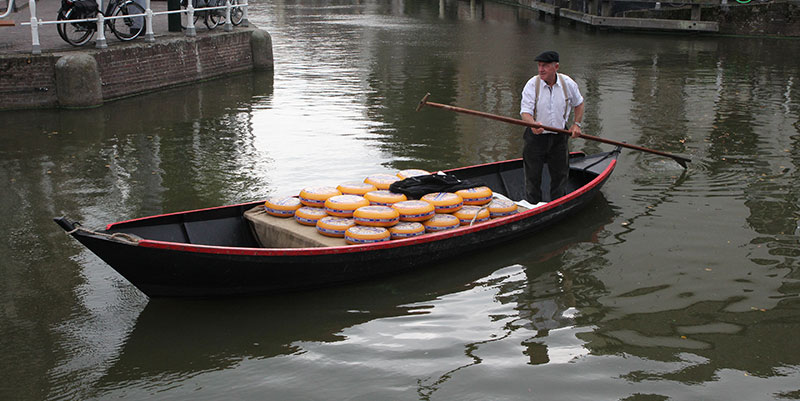
Alkmaar’s status as the cheese capital has become increasingly famous over the years as the cheese market became ever more popular. In the past most cheese was transported by boat or horse, and this centuries-old tradition has survived in part to this very day. During every market, cheese-laden boats sail from the North Holland Canal to the square, as they did centuries ago.
Just before 10:00 a.m. everyone waits for the market to get underway as the lady speaker welcomes visitors in as many languages as possible. She tells the public what they’re about to see and in a few minutes the bell is ringing indicating the start of action.
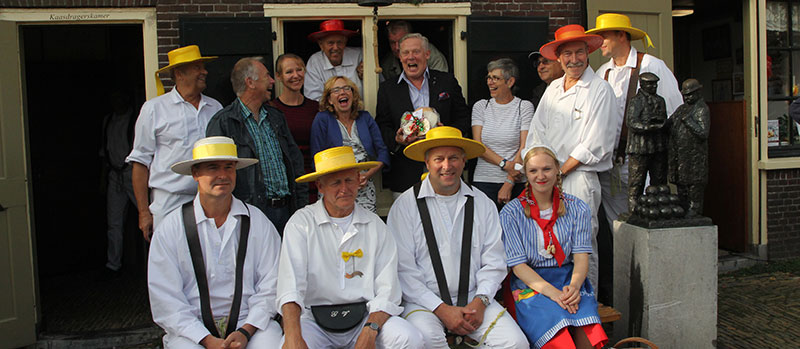
The ringing of the bell is often done by a visitor to the market at the invitation of the council of Alkmaar. For example it might be a famous Dutch person from sports or TV, or a foreign ambassador. The entire demonstration is repeated several times throughout the morning, from the approval of the cheese bearing to the carrying and the marketing, right up till about 12:30. This ensures that guests who arrive a little bit later can experience the whole show.
The market is most crowded when it first opens at 10 a.m., so you could arrive at 11 or 11:30 when it’s less crowded after the early arrivals depart. That later arrival gives a better viewpoint with fewer people in the way. However, it is also nice to arrive in town quite early before the crowds so you can enjoy the peaceful atmosphere of the pedestrian zone, and perhaps have breakfast at an outdoor café.

As soon as the market opens the samplers and traders go to work. Inspecting cheese is more than just looking at its exterior. Cheese is knocked on and a special cheese scoop is used to obtain a piece, which is then crumbled between the fingers, smelled and tasted to assess the relationship between flavor and percentages of fat and moisture.
Many lucky people in the audience get a free taste and some get to push the tool, something like an apple corer, into the cheese and pull out a sample for themselves.
Cheese is transported on the wooden barrow hanging between two cheese carriers, holding 8 Gouda cheeses, each weighing 13.5 kilos, carrying a heavy barrow swinging from ropes. Walking with that heavy barrow or stretcher appears much easier than it seems, but there is a specific technique.
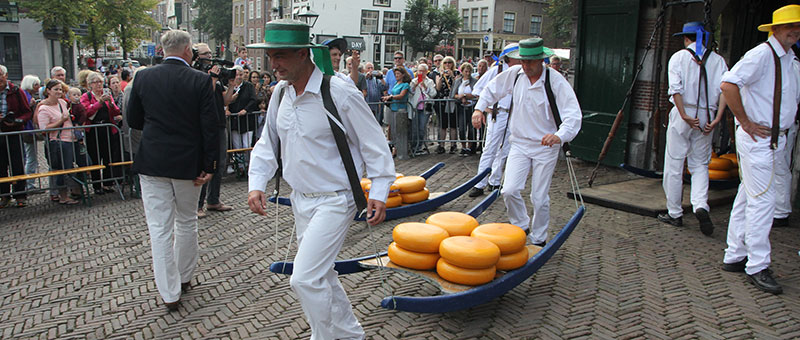
To facilitate the walking rhythm and prevent the stretcher from hitting their legs, the men walk ‘out of step’ in the strange-looking cheese bearers’ trot. This keeps the stretcher movement to a minimum, ensuring the barrow hangs as still as possible.
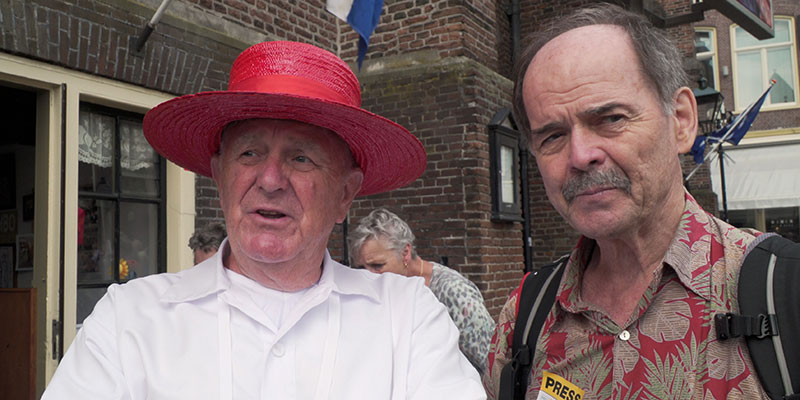
I had a chance to speak with an official of the group, Kees Koopman, who described the situation and history.
“I was the Cheese Father of this guild for many years, and now I am the tourist guide. We work with four groups; you see four different hat colors. Each group has six carriers and the seventh works on the scale–that is a very important man because in the early days, he counts the money from the buyers for each kilo that we carry. It’s very hard work. It’s about 120 kilo each time you walk here.
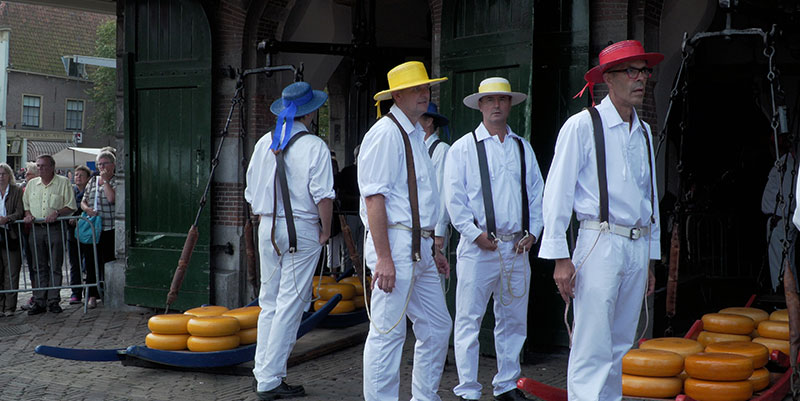
“We’ve got the two big factories in the north of the Netherlands and they still make millions of kilos of cheese each year, which is sold around the world. No actual trade is conducted at today’s market, which is mostly for the tourists, an accurate historical re-enactment illustrating how the market once functioned.
“Becoming a cheese bearer is an honorary job that is not a simple matter. Many cheese bearers are also business owners or have other jobs. When the market is over they go to their own jobs again, yes. Friday morning until 2 o’clock we are cheese carriers.
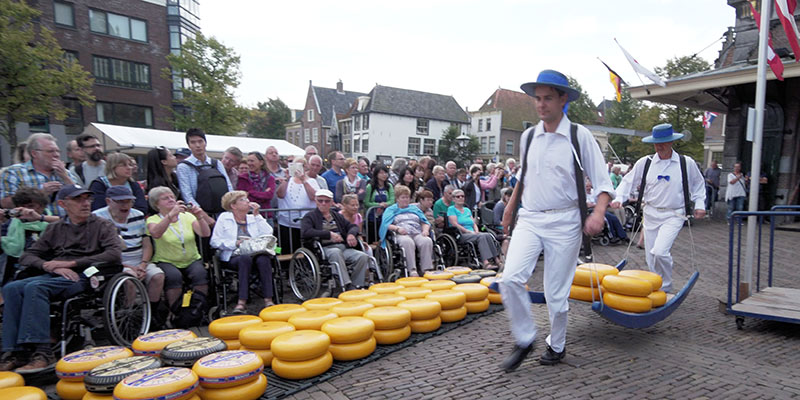
"Before becoming a cheese bearer, individuals serve as reserve workers. What you see is exactly the same as 200, or 300 years ago. Alkmaar is a very old city. It started in Alkmaar in 1245. Alkmaar got the right to be a city, 800 years as a city and the cheese market functioning 400 years.”
“And why are these cheeses so round?”
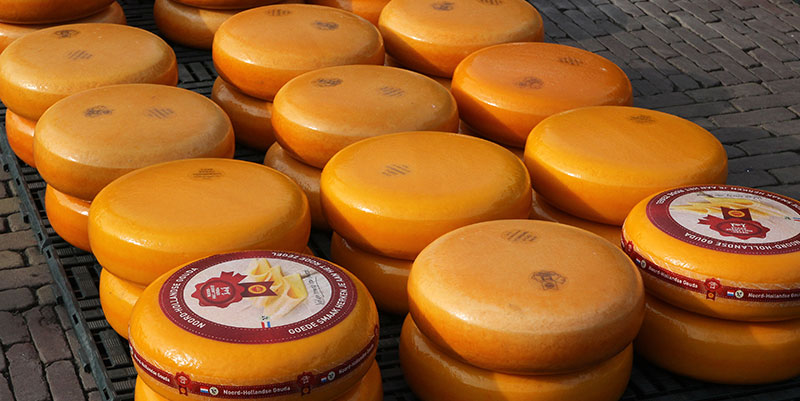
“Well, a long time ago, men performed the heavy work on the farm while women made cheese. Because the cheese had to be taken to the market, the women made them round in the shape of a wheel, making it easier to roll them, which facilitated their work. It also made them easier to stack.”
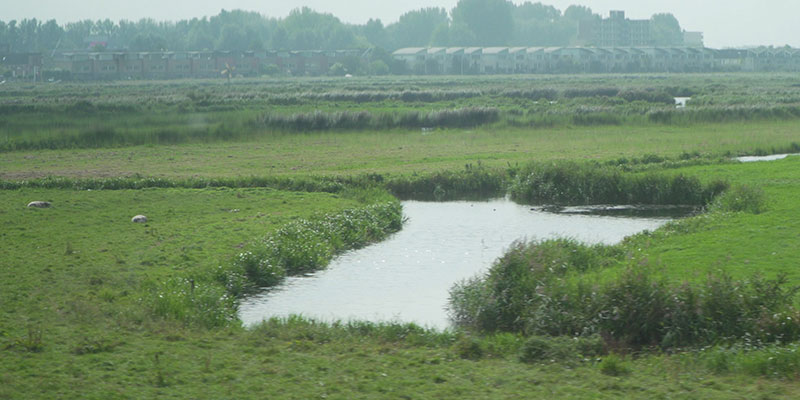
“Coming up by train I see many grass fields. Is that the pastureland for the cows?” I ask Mr. Koopman.
“Yes, well in the early times, in 1593 when they’re starting here around Alkmaar, everything was water. We’ve got big lakes around Alkmaar and when they pumped the water out, the farm is coming in, and so the cheese market is growing with that. Most of the green land that we see was pasture for cows. And the cheese was a way to preserve the milk—you need 10 liters of milk for 1 kilo of cheese. You see in this market deals 30,000 kilo of cheese. That’s a lot of milk.”
North-Holland Gouda has a rich, full flavor thanks to the fact that the pastures where the cows graze were once covered by the sea, which has provided a lot of mineral nutrition to that soil and the grasslands.
Notice the pronunciation: English speakers would normally pronounce the cheese “goo-da” but the Dutch would say something like like “hkouw-dah” as if clearing the throat with a guttural G. The city is pronounced “Al-uk-maar.”
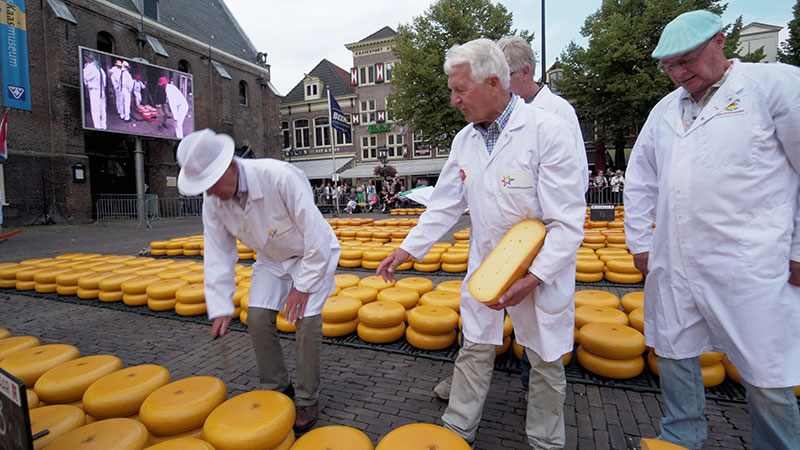
Price bargaining per kilo is still done in the historic way that’s been carried on here for centuries by clapping hands, and the purchaser summons the bearers and afterwards pays them.
Once the deal is closed, cheese carriers use a barrow to take the sold cheese to get weighed. The purse man, called tasman, weighs the cheese on one of three scales. The tasman supervises the correct weight being passed on to the buyer. The motto of the Alkmaar cheese carrier guild is “A false balance is an abhorrence in the eyes of the Lord.”
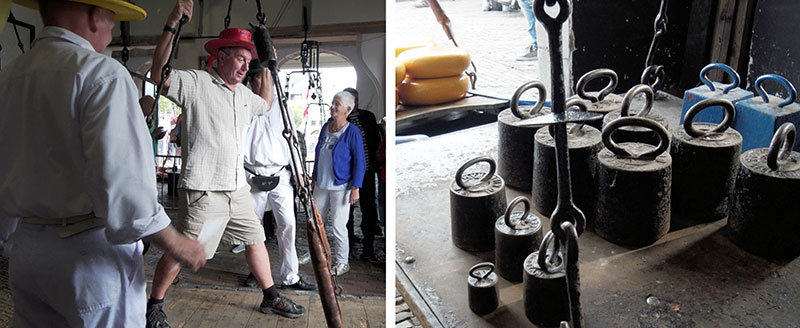
In the early times there were no scales at home, so this communal weighing house was used. The city government had the official right to inspect all the cheese, to weigh it, and levy taxes on each cheese coming into town.
After the weighing process, the cheese bearers carry the stretcher laden with cheeses across the market towards the hand barrows. The cheese is transported then by truck to the cheese packaging warehouse.
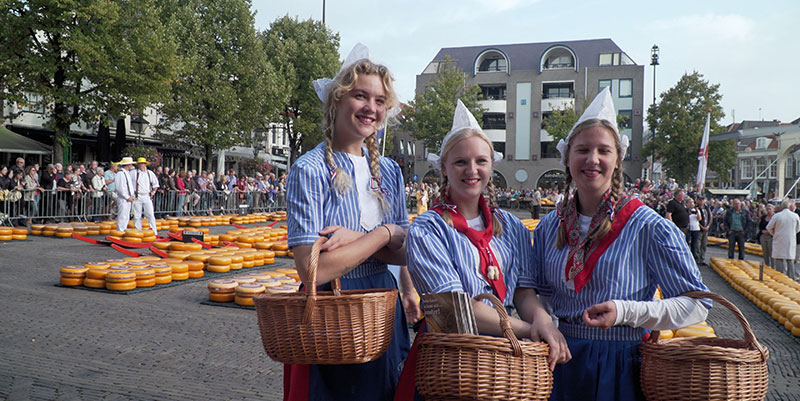
Cheese girls can be seen walking around the market wearing traditional costumes and clogs, like a living advertisement for Dutch cheese. They love being photographed with visitors and the world’s press. The cheese girl was introduced during the nineteen sixties as an advertising character for Dutch cheese in Germany and has remained popular right up through modern times.
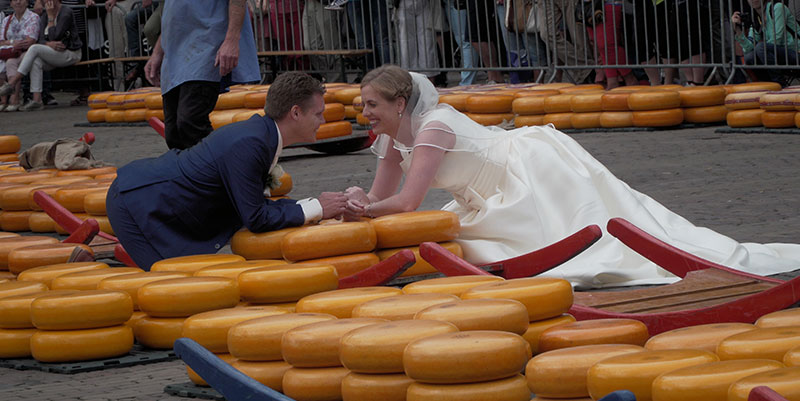
Cheese is so fundamental to the life of Dutch people that for some couples it becomes a backdrop for wedding photos. Cheese is a major element in the Dutch economy, one of its largest export products. 640 million kilos of cheese leave the country each year for destinations, including Germany, Belgium, France, Russia, the United States and Japan. 35% of cheese remains in the Netherlands, 45% remains in the EU and 20% goes outside. Germany is the largest consumer with some 225 million kilos. The Dutch are also partial to cheese, with an average cheese consumption of 19 kilos per person.
During the course of two centuries, the market place was enlarged no fewer than eight times before reaching its current dimensions.
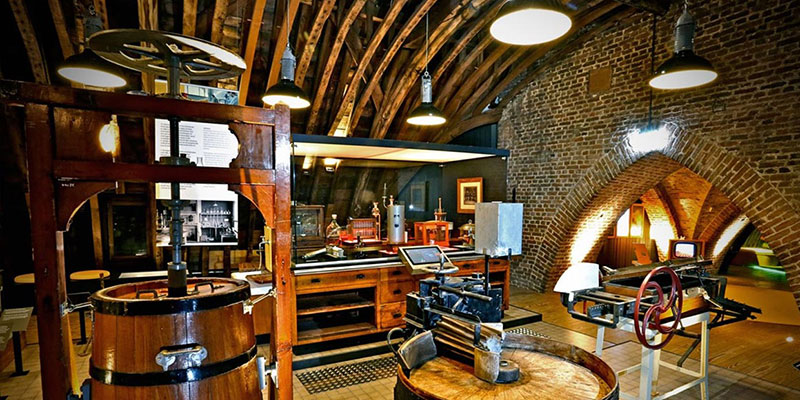
They even have a Cheese Museum upstairs in the Weighing House above the Tourist Information Office. The museum presents objects which richly illustrate the history of cheese making, farming culture and dairy trade. The collection includes historical artifacts and utensils, photographic images and film. Paintings are also exhibited, including twenty-four 16th century portraits of women from Holland.
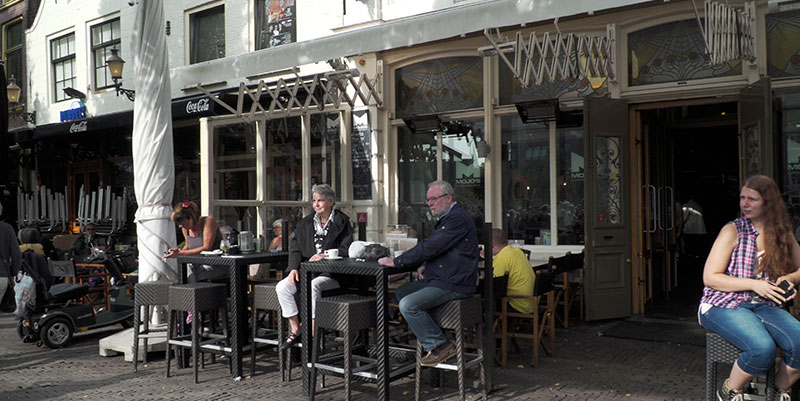
There are many restaurants and cafés alongside the market square where you can sit down and watch some of the cheese market activities from the comfort of your sidewalk table. Sometimes your best travel memories will come from just relaxing at a pleasant spot, like this café.
It will come as no surprise that everybody will have a chance to purchase as much cheese as they want from the vendors surrounding the cheese market area.
The cheese market ends at 12:30 but don’t leave the market square yet. You definitely want to take some time and look at all the vendors that have set up around the cheese market.
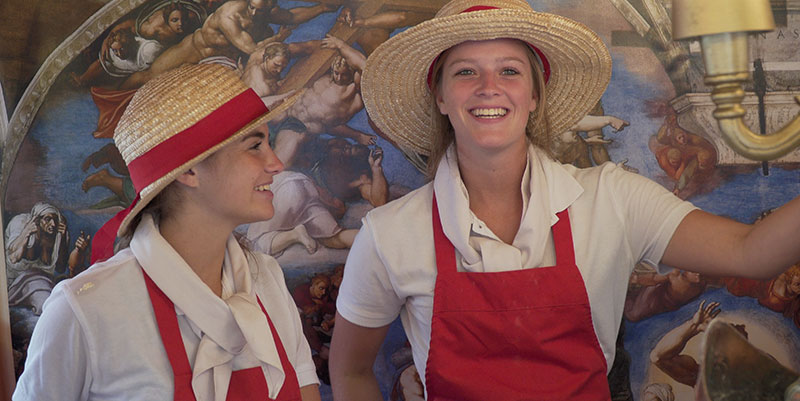
Sidewalk stands are carrying on a long historical tradition because up until the 19th century, most food and agricultural products were traded at street markets. They’ve got crafts and clothing and especially food. Try some of those delicious little pancakes, which are a basic, traditional Dutch food, whether they’re small and sweet like these preparations, maybe for breakfast or lunch, or like a crêpe at dinner time with savory fillings. Many restaurants specialize in pancakes but here it’s lovely to get them fresh at the sidewalk stand.
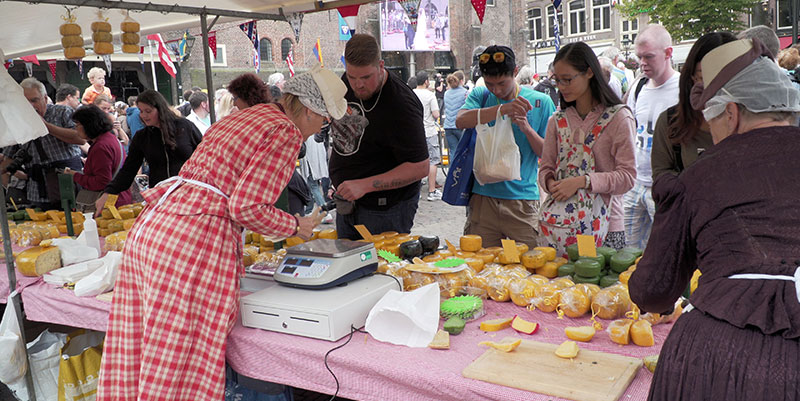
If you’re looking for a map or suggestions on where to eat or shop be sure to visit, either in person or on their website, the Tourist Information Office, located at the cheese market Waagplein. They are a fountain of information. Some of what you have been reading here was generously provided by them. Another website provides information about the wider region of North-Holland.
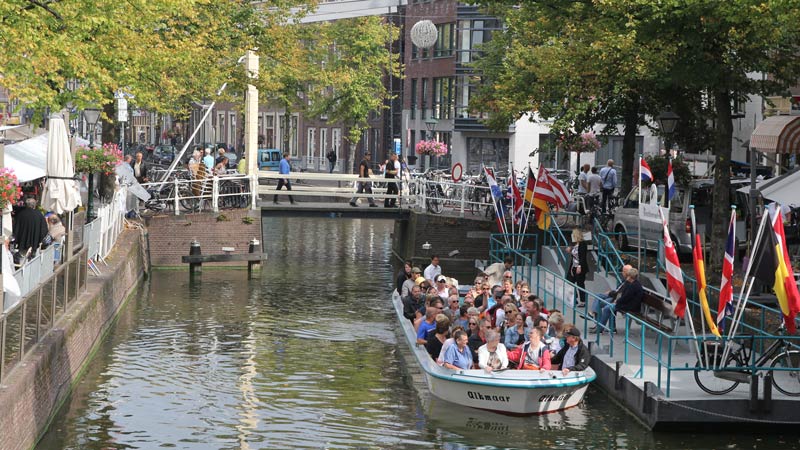
In addition to seeing the cheese market, the city itself is a beautiful place to explore as we describe in another page, including a boat ride.
There is much more to see in town besides the cheese market, so by all means spend a few hours when you get to Alkmaar and walk around in the charming little pedestrian zone. Then take a boat ride through the scenic canals, passing a lot of very old brick bridges and buildings.
See our other page for description of Alkmaar town.